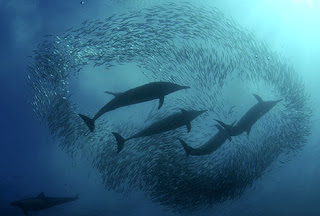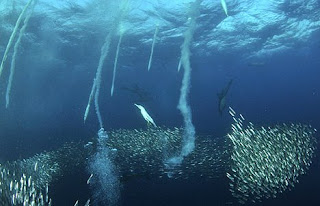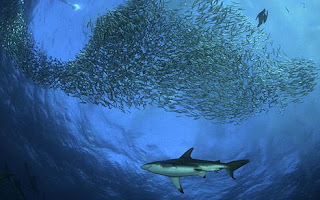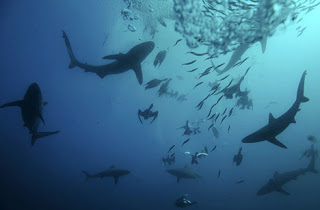From the last week of May through early July every year, South African pilchard spawn in the cool waters of the Agulhas Bank and move northward in droves for what researchers say could rival East Africa’s great wildebeest migration.
Their sheer numbers create a feeding frenzy along the coastline for sharks, dolphins, and even killer whales for a breathtaking event of the year’s greatest feast which is unique in both magnitude and complexity to the region.

As many as 18,000 Bottlenose and Common dolphins play their role like sheepdogs to expertly herd the sardines, pushing them to the shallow water where they’re more comfortable with hunting.
Running in hundreds of shoals, the sardines desperately attempt to throw off the deadly ambush of legions of predators that congregate in the formerly tranquil waters.
The silvery sardine’s instinctual behavior for defense to group together when they’re threatened creates massive ‘bait balls,’ which are short lived and seldom last longer than 10 to 20 minutes.




Once rounded up, sharks — Hammerheads, Coppers, Blacktip, Tiger, Spinner, and Great White — and other sea life including tuna and sailfish take turns diving through the bait balls, gorging on the fish as they sweep through the groups at will, feasting on massive mouthfuls of fish.
Cape Fur Seals also follow the shoals up the Eastern Cape coastline as far as Port St Johns.
The sardines aren’t even safe from the skies as they’re driven towards the surface, where voracious seabirds — Cape gannet, cormorants, terns and gulls — arrive in flocks and plummet through the blue waters like fighter planes from as high as 90 feet (30 meters), leaving vapor-like trails behind as they devour their victims en masse.
The shoals are often more than 4 miles (7 kilometers) long, 1 mile (1.5 kilometers) wide and 100 feet (30 meters) deep, clearly visible from spotter planes against the sandy shallow waters.
These bait balls can be anywhere from 33 to 66 feet (10 to 20 meters) in diameter and extend to a depth of up to 10 meters or more.


Untold thousands of marine animals — ’super-pods’ of as many as 2,500 dolphins, sharks, up to 300 on just one bait ball, and whales — devour the hapless plankton feeders, but surprisingly make little impact on the overall shoal size.
As one of Mother Nature’s most spectacular natural wonders on the planet, little is known about this phenomenon, but it’s believed that the water temperature has to drop below 70°F (21°C) in order for the migration to take place. Several years when the waters were too warm, the sardines have failed to ‘run.’
It occurs when a current of cold water heads north from the Cape Agulhas Bank — Africa’s most southerly point — during the southern hemisphere’s winter and swim north up to Mozambique, swarming the beaches of KwaZulu-Natal.
The run makes this trip through treacherous ocean currents along the rugged coastline and travels further east, disappearing into the deep Indian Ocean’s high seas — about a 1,000 mile ‘travelling buffet’ journey.


Sardines have a short life-cycle, living only from 2 to 3 years. Adult sardines about 2 years of age amass on the Agulhas Banks off the southern Cape coast where they spawn during spring and summer, releasing tens of thousands of eggs into the water which are then fertilized by males.
The eggs drift west and north with the current into the waters off the west coast, where the larvae mature and develop into juvenile fish. Once strong enough, they aggregate into dense shoals and migrate southwards, returning to the Agulhas banks in order to complete their life cycle.
Thermal satellite images now suggest currents rather than spawning or large plankton blooms trigger the migration. Scientists believe it’s primarily the cool water coming up the coast in the winter months that allows them to extend their range.
But experts are still mystified as to why the fish leave nutrient-rich feeding grounds for emptier, sub-tropical climes.
In these times of dwindling fish stocks, the shoals surprisingly represent a mere fraction of South Africa’s sardine fishery. Just 800 tons are caught off KwaZulu-Natal every year compared to 100,000 tons on the Agulhas Banks.






The Sardine Run also coincides with the annual migration of Humpback Whales that move north for the season into warmer water to mate and calve, performing their own spectacular display of breaching from the waters. They travel up to 5,000 miles (8,000 kilometers) for the journey in what’s probably the longest mammal migration known to man.
It’s been said that the sardine run is the only place in the world where scientists and tourists can see such extensive predation so close to shore, attracting many adventure seekers and extreme divers for this unique hunting collaboration and feeding competition between different species in a dazzling wildlife extravaganza as one of the largest marine events on the planet.
Great South African Sardine Run


